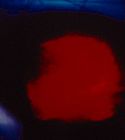 __ Es __ I | |

| |
| Names | |
|---|---|
| IUPAC names
Einsteinium triiodide Einsteinium(III) iodide | |
| Identifiers | |
| CAS Number | |
| 3D model (JSmol) | |
| ChemSpider | |
| CompTox Dashboard (EPA) | |
InChI
| |
SMILES
| |
| Properties | |
| Chemical formula | EsI3 |
| Molar mass | 632.796 g/mol |
| Appearance | amber-coloured solid, glows red in the dark |
| Structure | |
| Crystal structure | Hexagonal |
| Space group | R3 |
| Except where otherwise noted, data are given for materials in their standard state (at 25 °C , 100 kPa). Infobox references | |
Einsteinium triiodide is an iodide of the synthetic actinide einsteinium which has the molecular formula EsI3. This crystalline salt is an amber-coloured solid. It glows red in the dark due to einsteinium's intense radioactivity.
It crystallises in the hexagonal crystal system in the space group R3 with the lattice parameters a = 753 pm and c = 2084.5 pm with six formula units per unit cell. Its crystal structure is isotypic with that of bismuth(III) iodide.
References
- ^ Arnold F. Holleman, Nils Wiberg: Lehrbuch der Anorganischen Chemie, 102nd Edition, de Gruyter, Berlin 2007, ISBN 978-3-11-017770-1, p. 1969.
- R. G. Haire, ORNL Report 5485, 1978.
- J. R. Peterson: "Chemical Properties of Einsteinium: Part II", in: G. T. Seaborg (ed.): Proceedings of the 'Symposium Commemorating the 25th Anniversary of Elements 99 and 100', 23. January 1978; Report LBL-7701, April 1979, pp. 55–64.
Further reading
- Haire, Richard G. (2006). "Einsteinium". In Morss, Lester R.; Edelstein, Norman M.; Fuger, Jean (eds.). The Chemistry of the Actinide and Transactinide Elements (PDF). Vol. 3 (3rd ed.). Dordrecht, the Netherlands: Springer. pp. 1577–1620. doi:10.1007/1-4020-3598-5_12. Archived from the original (PDF) on 2010-07-17.
| Einsteinium compounds | |
|---|---|
| Es(II) | |
| Es(III) | |
| Es(IV) | |
| Es(VI) |
|
| Salts and covalent derivatives of the iodide ion | |||||||||||||||||||||||||||||||||||||||||||||||||||||||||||||||||||||||||||||||||||||||||||||||||||||||||||||||||||||||||||||||||||||||||||||||||||||||||||||||
|---|---|---|---|---|---|---|---|---|---|---|---|---|---|---|---|---|---|---|---|---|---|---|---|---|---|---|---|---|---|---|---|---|---|---|---|---|---|---|---|---|---|---|---|---|---|---|---|---|---|---|---|---|---|---|---|---|---|---|---|---|---|---|---|---|---|---|---|---|---|---|---|---|---|---|---|---|---|---|---|---|---|---|---|---|---|---|---|---|---|---|---|---|---|---|---|---|---|---|---|---|---|---|---|---|---|---|---|---|---|---|---|---|---|---|---|---|---|---|---|---|---|---|---|---|---|---|---|---|---|---|---|---|---|---|---|---|---|---|---|---|---|---|---|---|---|---|---|---|---|---|---|---|---|---|---|---|---|---|---|
| |||||||||||||||||||||||||||||||||||||||||||||||||||||||||||||||||||||||||||||||||||||||||||||||||||||||||||||||||||||||||||||||||||||||||||||||||||||||||||||||
This inorganic compound–related article is a stub. You can help Misplaced Pages by expanding it. |